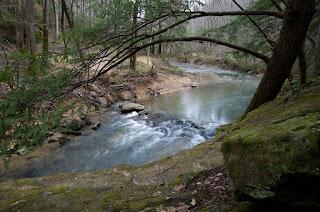
Black Warrior River
Were concerns about the unlawful discharge of pollutants through underground water a driving force behind the North Birmingham Bribery scandal? The question arises from an article at the Birmingham Business Journal, and banbalch.com addresses it in a post under the headline "Drummond, Alabama Power, and the “Illegal Discharge of Pollutants through Underground Water.” Writes Publisher K.B. Forbes:
Is the contamination of underground water the possible genesis of the North Birmingham Bribery Scandal, born at the offices of Balch and Bingham?
The Birmingham Business Journal reported this week:
The U.S. District Court of the Northern District of Alabama determined that substantial, contaminated sub-surface flow discharging from Drummond’s site into the Black Warrior River near Praco on a daily basis is an illegal discharge of pollutants through underground water in violation of federal law.
Is Alabama Power’s Miller Steam Plant next?
That question grows from a CNN report two months ago about environmental issues facing Alabama Power. From banbalch.com:
This past December, CNN reported that the EPA was probing Alabama Power. CNN’s visual and interactive story on polluting ash ponds outlined potential environmental disasters and the “money-making” schemes surrounding those foolish decisions.
Alabama Power’s Barry Plant (and toxic ash pond) near Mobile, Alabama was a central figure of the investigative story and highlights the controversy surrounding the future of these contaminated ash ponds.
But Alabama Power’s Miller Steam Plant appears to raise more questions and concerns than Barry.
As we reported in March of last year:
North Birmingham appears to have been a sideshow, a distraction to the real objective: squashing the tiny environmental group GASP before the group could start probing the Miller Steam Plant, one of the biggest greenhouse polluting, coal-burning plants in the nation, according to recent news reports.
We, the CDLU, are not environmentalists.
However, having investigated numerous unsavory businesses and inept government agencies in the past two decades, we understand that something at the Miller Steam Plant in Jefferson County made Alabama Power concerned, gravely concerned.
We believe that concern could have been what environmental groups like GASP and others have been discussing for years: ash ponds of coal waste next to water supplies.
Now we have obtained a letter filed… with the Alabama Department of Environmental Management by an environmental engineer who writes:
While I am certain that the current use of these ash ponds complies with current standards, past practices (unregulated at the time) may have resulted in highly toxic wastes being deposited in the ponds.
[T]he fact that the Miller facility was constructed in the late 1970’s, prior to the full implementation of the federal TSCA and RCRA regulations mean that it is possible that PCBs, asbestos, and boiler cleaning wastes could have been placed (legally) in the pond. When coupled with the fact that much older Powell Avenue Steam Plant ash was placed in the past, I believe, at a minimum, ADEM should have required APC to conduct historical research to determine if the extent, if any, toxic substances were placed in the pond.
What needs to happen next? That requires a multi-pronged answer:
[The EPA] needs to investigate if historic toxic waste was ever placed into the ash pond and test deep inside the ash pond, and the water in and around the ash pond, known as the Locust Fork.
Has there been seepage? Have toxins knowingly been entered into the water supply? Did anyone know and cover this up?
Then there is Drummond’s other headache: Ketona Lakes. We addressed hat issue last year, writing:
For over 35 years, the site of two former quarries has been hidden from public view. Located in Jefferson County, not far from North Birmingham and smack in the middle of the City of Tarrant, the Ketona Lakes are quarries now filled with water.
The water is allegedly extremely contaminated and toxic.
Sources tell us that Drummond acquired the property when it purchased ABC Coke, and the site had extensive underground pipes that used to go directly underground to ABC Coke.
Drummond allegedly sealed off the pipes, tore down all physical structures, and then secured, fenced, and fully abandoned the site in 1985, thinking no one would know or care.
Ketona Lakes was the site of a former chemical company and decades of harmful chemicals and toxins have allegedly stayed in the soil and water.
As the SEC probes the Crosswhite Scandal and federal investigators interview hired smear artists allegedly affiliated with the Matrix Meltdown, the EPA and U.S. Department of Justice should dig deep into these alleged toxic sites, and the overflowing resources and web of entities and officials used to protect them from scrutiny, some for decades.
